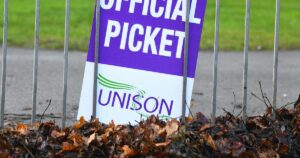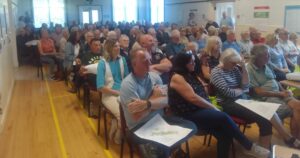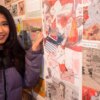My conversation with Jim Ross of Romesbeoch, Shawhead, gets off to the best of starts – it turns out he was born in Stranraer, as was I.
So it’s a Wigtownshire man with whom I’m talking to across the wee coffee table, upon which his wife Selina soon places a steaming mug of coffee and a plate of millionaire’s shortbread.
Jim, renowned for his work in rearing premier quality Galloway cattle, for promoting the breed internationally and as a cattle judge both in Scotland and across the world, tells me he and Selina have four children – Lindsay, Matt, Doug and Carolyn – along with six grandchildren – four boys and two girls.
Now 71, Jim reveals his family had connections all over the south west, all tied in with the agricultural life of the times.
“On my mother’s side, my grandpa Jimmy Ferguson was farm manager at King’s Laggan at Gatehouse,” he begins. “While on my dad’s side my grandparents Matt and Minnie Ross hailed from Ayrshire.
“My grannie Ross – their name was White – originally had a farm called Peggy’s Hill just outside Ayr on the Carsphairn road.
“It’s all houses now – I think there’s a Peggy’s Hill Drive where the farm used to be.
“My grandpa Matt Ross belonged to Colmonell, and when he and Minnie got married he became chauffeur for the Earl of Inchcape at Glenapp.
“It was his folks that started selling curling stones made from granite off Ailsa Craig.
“His middle name was Begg, the same Begg that started making the ploughs at Mauchline smiddy.
“After Glenapp they took on the Hoose o’ the Hill at Bargrennan and ran that as a hotel.
“Then they got the chance of Tannylaggie Farm and the Knowe near Bargrennan, in the moors of Wigtownshire, and decided to take them on.
“My dad Jimmy attended the Douglas Ewart High School in Newton Stewart which was nine miles away.
“He told me him and his pals would all gather at the brig at Bargrennan and cycle together to school every day.
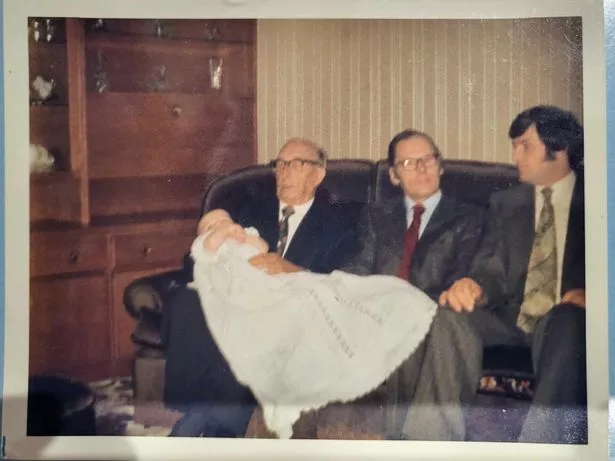
“My dad met my mum Betty and got married from Tannylaggie, which is where they stayed, and I was born at Stranraer in 1952.”
I ask Jim if he has any memories from Tannylaggie – where, I learn, the Ross family’s 77-year association with Galloway cattle began – but it turns out he was only an infant when the family was on the move again.
“It was in 1947 that grandpa Matt bought three females at the Castle Douglas sale and that was the start,” Jim recalls with a smile.
“One was from Over Barskeoch at Dalry, one from Mochrum between Corsock and Parton, and the other from Boreland of Southwick.
“All got the Knowe prefix but the first three calves were all bull calves.
“The next year it was the same, and the third year they had two bull calves and one heifer calf.
“They were hoping for heifers to come because they would not have been able to buy any more.
“That was when Matt and Jimmy bought Glaisters Farm near Corsock at the back end of 1952.
“Everybody moved there, mum, dad and I going slightly later, in May 1953.
“The war had finished only seven years before I came along,” Jim adds.
“It must still have been very hard for folk, but as kids we never realised that.
“There’s a desk up at Romesbeoch that’s got rationing cards for fuel and food items and other things in it.
“But I can’t get into it because the wood has swollen and the drawers are jammed shut.
“There’s a wee bit of history in there, no doubt.”
As Glaisters, Jim minds, was mainly a sheep farm it meant that the early summer clipping was a big event in the year.
“All the farms round about neighboured with one another for the clipping and marking, and I fair enjoyed that,” he recalls.
“There could be nine to 12 shepherds from neighbouring farms came to Glaisters and mum would feed them.
“Work would start about 8.30am and at 10am out would come your soda scones and cheese, and oven scones with butter and jam – it was all homemade stuff.
“She would bring them over in a big basket to the sheep pens.
“Then at midday everybody went into the farmhouse for dinner.
“That would be three courses, soup, mince and tatties or lamb stew and tatties, then pudding, which was always trifle.
“It was all hand shears in those days, some clipping the sheep on a stool, others on the ground.
“So they would need all that grub to see them through the day.
“And when they were finished it would be back to the house for tea, which would be macaroni cheese or something of that nature.
“It was always great banter, tremendous.
“At Kings Laggan it was the same there, men would go and help and it would be different banter, because they were a different bunch of shepherds.

“I remember up there I got a wee trike for my Christmas – I would only be two or three – the one with pedals on the front wheel you pushed with your feet.
“Mum and dad had a wee van, and I cycled that wee trike round and round in the back all the way home to Glaisters.
“When we stopped at the double gates at the road-end I got a hell of a row for all the racket pedalling about in the back!”
School days for Jim, it transpires, were generally happy – apart from the wrench of moving to “the big school”.
“I went to school at Corsock Primary – my sister Anne was born at Glaisters in 1961 – then Dalry Secondary School,” he tells me.
“Corsock had two teachers and I enjoyed school – but going from Corsock to Dalry was a big move.
“We were put on a school bus to Dalry and that was it – you were flung in at the deep end.
“I played football at school – there was no rugby – and left when I was 15.”
At this point, I ask Jim when he began taking an interest in Galloway cattle.
“I have always loved working with the Galloways,” he says.
“Glaisters was 1,000 acres but of those only 32 were good in-bye land.
“All the rest was hill ground – which now is all covered in trees.
“When we were there we ran about 400 Blackface
ewes and 40 pedigree Galloway cows.
“I was brought up with Galloway cattle and I’d maybe be five or six when I started feeding and dressing them – brushing, washing and clipping.

“The only thing I wanted at Glaisters was a white Galloway, the ones with black ears and muzzle, but they were always too expensive.
“But when I was nine I got my first one, a dun Galloway called Orange Blossom of Cholmondley.
“Grandpa Matt bought her for me at the October sale at Castle Douglas.
“I can still remember going into that sale and my grandpa saying to me ‘away and pick a dun Galloway heifer calf’.
“I could take you to the very place in the market, more or less the same spot, that he said that.
“So away I went on my own, nobody else with me.
“There were a lot of duns to choose from but I picked a shortlist of two.
“I chose one but I mind my grandpa advised me to pick the other, Orange Blossom, and that’s what I did.
“Then I joined the Galloway Cattle Society, aged nine, and was the society’s youngest member.
“The next summer, 1962, I showed her at New Galloway Show – there’s a photo of me in the Galloway News with her on the halter.
“She won third prize in her class – and I remember that the two who beat her went on to be winners at the Highland Show.
“That was me hooked on Galloways from that point.”
Orange Blossom, Jim explains, was at Glaisters for breeding and every year would be taken down to Milnmark, where Peter Fingland had a dun Galloway bull.
“That was always an excitement and she stayed there for six weeks.
“Her very first calf was a bull calf and we sold him for 100 guineas.
“He went to a very well renowned fold of dun Galloways.
“Next year she had a bull calf again and he got castrated, much to my disgust.
“We showed him at the Winter Fair in Edinburgh, where he was third in class.
“After that he went on to Smithfield but I was only 11 and too young to go.”
By the time he was 15, Jim tells me, big changes were afoot when his dad decided he wanted a dairy – and for that, good land, not coarse hill ground, was required.
“That’s how we ended up at Romesbeoch,” he explains.
“It had 184 acres and it was all arable land.
“Me being a stubborn young chap, I dug my heels in and said I was not going.
“But the carrot was dangled in front of me that I could pick out six Galloway cows and take them with me.
“It was a wee bribe I suppose, but I had the pick of them and the six I took were the best in my eyes.

“The bull came as well, and his name was Drumwhirn
Bill.
“Grandpa maybe was quietly pleased the cattle came to Romesbeoch – I think he was quite happy.
“Romesbeoch had 50 dairy cows which we had bought with the place.
“There was a farm sale at that time and we bought six more heifers in calf for £56 apiece, six bulling heifers at £48 and six heifer calves for £18 – all black and whites out of an Ayrshire cow by a Friesian bull.
“That was 1967.”
First task for Jim senior at Romesbeoch, Jim tells me, was to buy a new International 434 tractor.
“It cost £800 and dad asked if it came with power steering.
“Gordon’s at Castle Douglas said no, but it could go in for an extra £52.
“There was no cab so that was ordered from Gordon’s as well at a cost of £200.
“Fodder was grown on the place and we made silage and hay in the summertime.”
Jim smiles when I ask if barley was grown also, as back then bruised barley was a feed staple for cattle.
“Well, when we came to Romesbeoch that August there were 32 acres of standing barley,” he says with a wry smile.
“It was a wet back end and the crop was not combined until the third week of October.
“We didn’t even get a ton to the acre and there was no straw either.
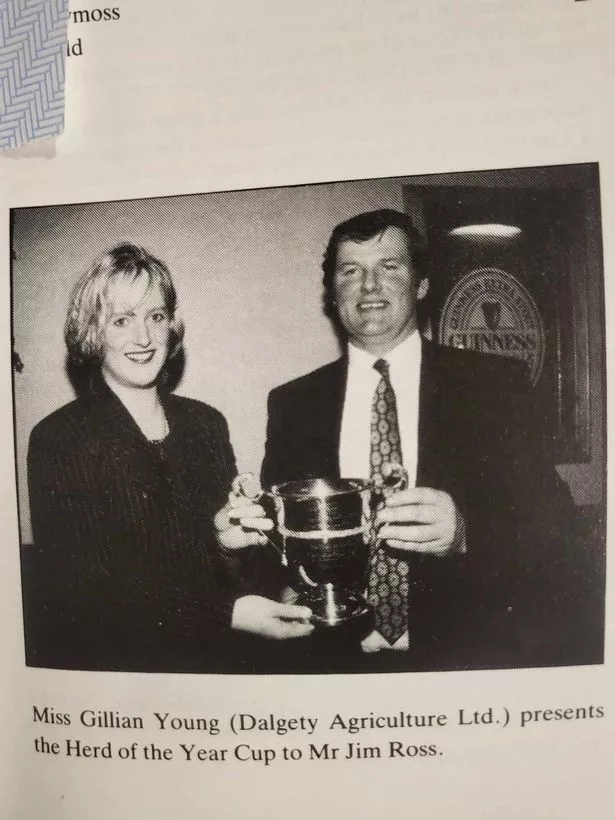
“By the time we paid for the combine there was hee-haw left.
“I mind my dad saying ‘There will never be any more barley grown on Romesbeoch!’.
“And his words have remained true to this day.”
Off the farm, I learn that Jim has had an involvement with Lower Nithsdale Young Farmers stretching back 55 years.
“I joined at 16, got a lot of fun out of it and learned a lot,” he tells me.
“I competed in stockmanship at the Royal Highland Show and won the Morphie Trophy for best pair in the beef section with Ian McIntyre from Whauphill and was runner-up for stockman of the year.
“I’m president of Lower Nithsdale Young Farmers to the present day – I see it as giving something back in return for all the knowledge I acquired.
“The club is still doing very well – it’s coming up to its 80th anniversary next year and I’m chairman of the committee planning the celebrations.
“Oh aye, and I met my wife Selina Deans through the young farmers,” adds Jim with a hint of devilment.
“She was secretary and I was chairman – and things just blossomed from there!”
Don’t miss next week’s Galloway News for part two of Jim’s story – the growth of the Romesbeoch Galloway herd, the disaster of foot and mouth, and recovery.


